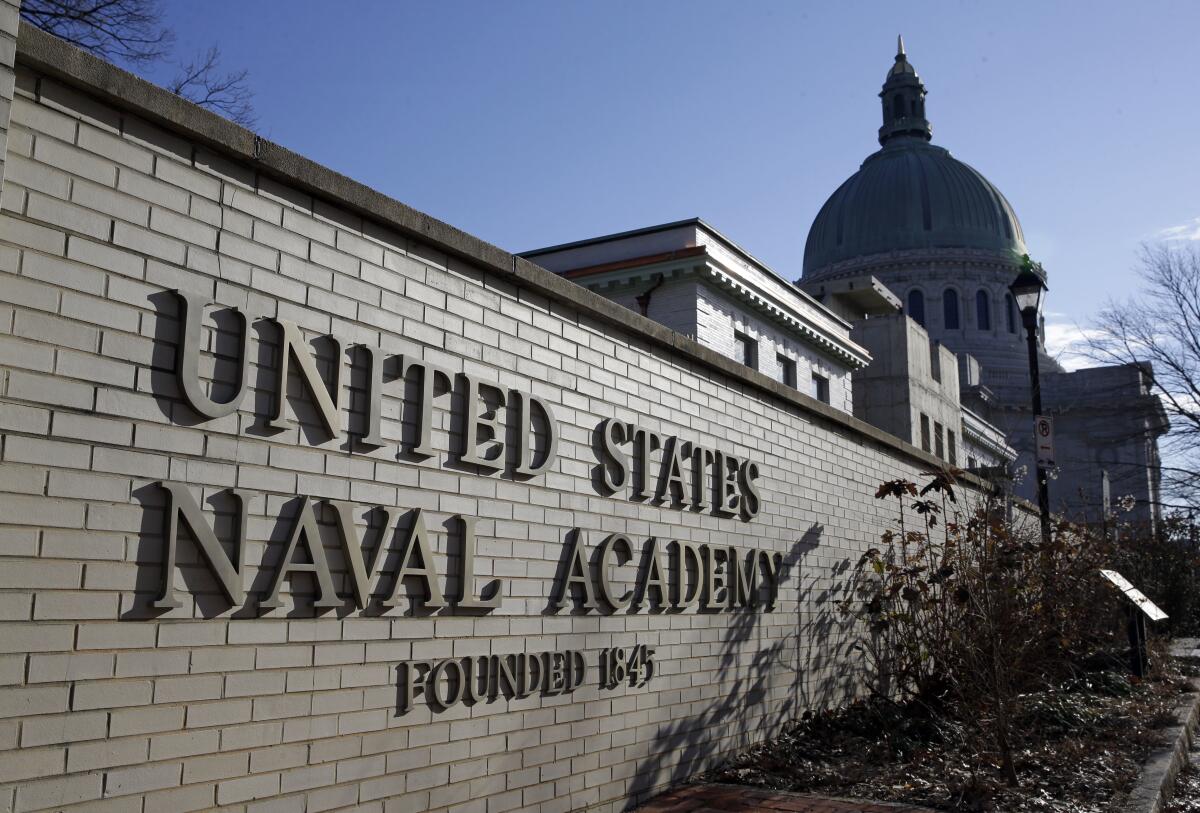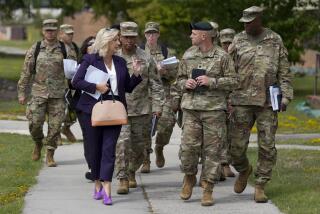1 in 5 female students at U.S. military academies report unwanted sexual contact, officials say

- Share via
WASHINGTON — Reported sexual assaults at U.S. military academies shot up during the 2021-22 school year, and 1 in 5 female students reported in an anonymous survey that they had experienced unwanted sexual contact, the Associated Press has learned.
U.S. officials said student-reported assaults at the Army, Navy and Air Force academies jumped 18% overall compared with the previous year. The increase occurred largely in the Navy, which had nearly double the number of reported assaults in 2022 compared with 2021. It’s unclear whether the phasing out of COVID-19-related restrictions contributed to the increase, including at the U.S. Naval Academy, which is directly adjacent to bars in downtown Annapolis, Md.
A student survey accompanying the report found increases in all types of unwanted sexual contact — from touching to rape — at all the schools. It cites alcohol as a key factor.
The military services and the academies have struggled for years to combat sexual assault and harassment, with myriad prevention, education and treatment programs. But despite volumes of research and expanded programs, the numbers continue to grow. Young Army soldiers last month dismissed videos and training as outdated and told service leaders that small group discussions would be more effective.
The increases have triggered outrage on Capitol Hill and a steady stream of legislation. But the changes have not appeared to make a dent in the problem, although officials argue that expanded assistance programs have encouraged more victims to report the crimes.
According to U.S. officials, 155 students reported assaults during the 2022 school year, compared with 131 the previous year. Of those, students at the U.S. Naval Academy reported 61 — nearly double the school’s total for the previous year, when there were 33, which was by far the least at all the academies for that year.
Reports of sexual assaults across the U.S. military rose 13% last year, driven by significant increases in such incidents in the Army and the Navy.
Cadets at the Air Force Academy in Colorado reported 52, the same as the previous year, and those at the U.S. Military Academy at West Point in New York reported 42, a slight decrease from the previous year’s 46.
Not all of the assaults happened while the students were enrolled in the academies. Because students are encouraged to report assaults, they sometimes come forward to talk about events that happened in the years before they started school there. As a result, 16 students reported an assault in the 2021-22 school year that occurred prior to joining the military.
Thirty-five cases involved civilians, active-duty service members and prep school students who allegedly were assaulted by someone who was a student. Altogether, the total number of reported assaults with any connection to a student was 206 — about 28% higher than last year’s 161.
U.S. officials provided details about the findings on condition of anonymity because the report had not yet been released.
The COVID-19 pandemic led to a brief dip in cases at the academies during the shortened 2019-20 school year, when in-person classes were canceled and students were sent home in the spring to finish the semester online.
Ukrainian authorities believe cases of sexual assault by Russian occupiers are vastly underreported. Shame and many factors underlie survivors’ unwillingness to report rapes.
At the start of the 2020-21 school year, students faced restrictions due to the ongoing pandemic. But as those were slowly scaled back, and bars and restaurants reopened, the numbers began to increase again. Officials said it’s hard to tell what, if any, impact the pandemic had on assaults during the 2021-22 school year.
The Pentagon puts out two reports every year on the number of sexual assaults reported by military academy students and by U.S. service members. But because sexual assault is such an underreported crime, the department also conducts anonymous surveys every two years to get a clearer picture of the problem among both the students and the active-duty population. Pentagon leaders believe the survey provides a more accurate depiction of the assaults and the contributing factors.
Based on the surveys, students at the academies are less likely to report an assault than service members who are out of school. Students may worry more about the impact on their military career or even on the career of their attacker.
According to the latest survey of academy students, 21.4% of women said they experienced unwanted sexual contact in the 2022 school year, compared with about 16% in 2018, the last year the survey was done, due to COVID-19 restrictions. For men, the rate went from 2.6% in 2018 to 4.4% in 2022.
Based on the survey, attacks against women were most often by a male who was usually in the same class year and more than half the time knew them from school or other activities. Attacks on men were more often — 55% of the time — by a female who was in the same class year and knew them.
Start your day right
Sign up for Essential California for the L.A. Times biggest news, features and recommendations in your inbox six days a week.
You may occasionally receive promotional content from the Los Angeles Times.
Alcohol use was involved in well more than half of the cases reported in the survey, with a high of 65% at the Naval Academy. The report recommends additional alcohol use policies.
The report also found that sophomores and junior men were most at risk. And women are still far more likely to report an assault than men.
Pentagon leaders have for years pushed public campaigns urging students to report any attacks, and they argue that an increase in assault reports suggests that students feel more comfortable coming forward to seek help.
According to the report, the rates of unwanted sexual contact reported in the survey are “at or above civilian rates” based on 2014 and 2018 statistics from the American Assn. of Universities. No other more recent statistics were available, so it’s difficult to accurately compare the military academies with nonmilitary universities.
More to Read
Sign up for Essential California
The most important California stories and recommendations in your inbox every morning.
You may occasionally receive promotional content from the Los Angeles Times.












